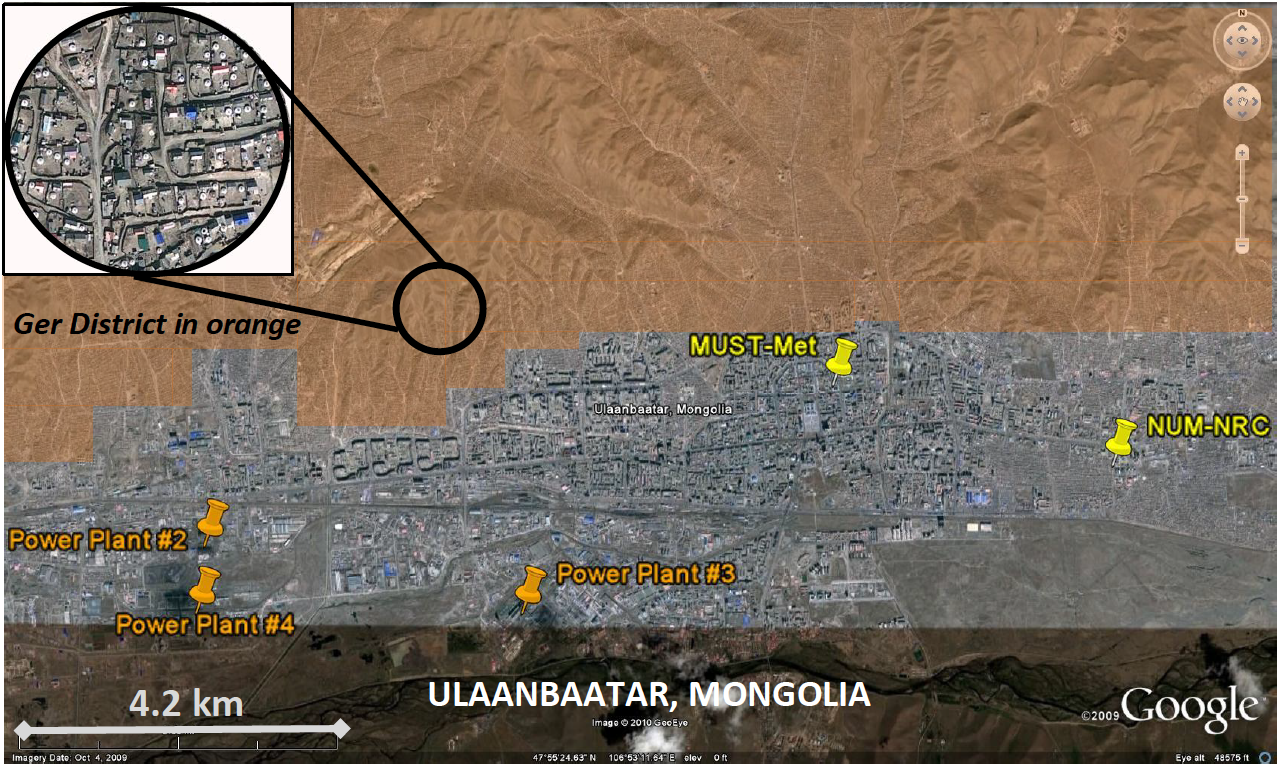As I mentioned in the previous post, this blog will feature a series called, “Meet Mongolia’s Scientists.” Today is the first installment!
* * * * *
Gerelmaa Gunchin is a nuclear physics Masters student at the National University of Mongolia (NUM). Nuclear physics may seem a subject that is far removed from the study of atmospheric science, but for Gerelmaa the subject was her gateway into the field of Ulaanbaatar air pollution.
Ever since she was a nuclear physics undergraduate at NUM, Gerelmaa has been working with Prof. Sereeter Lodoysamba and Dr. Dagva Shagjjamba of NUM and the Nuclear Research Center in Ulaanbaatar and collaborators at the Institute of Geological and Nuclear Sciences, part of the National Isotope Centre in New Zealand. Together, they have been studying source appointment of aerosol pollution in Ulaanbaatar by performing elemental analysis on aerosol using nuclear techniques.

Gerelmaa Gunchin placing collected PM samples into a Smoke Stain Reflectometer, an instrument that measures BC.
One of the primary forms of air pollution plaguing UB is aerosol – or particulate matter (PM). PM is solid material that is suspended in the air. There all kinds of examples, both man-made and natural: dust, smoke, and even ice cloud crystals. You’re probably inhaling various other examples at this very moment! For the research project Gerelmaa has participated in, she has collected PM10-2.5 – or aerosol of less than 10 microns but greater than 2.5 microns in diameter, PM of less than 2.5 microns in diameter (PM2.5), and black carbon (BC) at an air quality monitoring site, situated near the Nuclear Research Center in Ulaanbaatar. She then had the opportunity through a fellowship provided by the RCA (Regional Co-operative Agreement for Research, Development and Training related to Nuclear Science and Technology for Asia and the Pacific), a program within IAEA (International Atomic Energy Agency), to continue this research in New Zealand, at the National Isotope Centre. Over the summer of 2008, Gerelmaa performed Ion Beam Analysis on PM samples from Ulaanbaatar to discover their elemental composition.

Sites relevant for air pollution studies in Ulaanbaatar, Mongolia. In orange are various emission source sites (e.g. powerplants, ger district) and in yellow, labelled "NUM-NRC" is the site where Gerelmaa, along with coauthors, collected PM samples.
The results of this research, of which Gerelmaa is a co-author, were published this month in the journal of Atmospheric Pollution Research (which appears to allow free access to all of their journal articles!). One of the key findings from this study is that mass contributions from coal burning sources showed an increasing trend from 2004 to 2008. Typically, coal burning sources dominated the mass in the PM2.5 bin, which are particularly harmful to humans’ respiratory system. From the PM2.5 elemental analysis, the mass is dominated by two separate components: high temperature coal burning (e.g. emissions from power plants) and low temperature coal burning (e.g. emissions from domestic stoves). The work also shows that dust – from both urban and remote sources – is the largest constituent of the material found in the PM10-2.5 fraction of the collected aerosol.
Gerelmaa plans to continue this work as she finishes up her Master degree at NUM. After that, she would like to go on and complete her doctorate degree. For her long term plans, Gerelmaa sees herself in Mongolia, as a professor, teaching and researching in the environmental sciences.
Өмнөх бичлэгтээ дурдсаны дагуу уг блог маань “Монголын эрдэмтэдтэй танилцана уу” хэмээх цувралтай болж байгаа билээ. Өнөөдөр анхныхаа дугаарыг хүргэж байна.
* * * * *
Гүнчингийн Гэрэлмаа нь Монгол Улсын Их сургуулд цөмийн физикийн магистрантурт суралцдаг оюутан юм. Цөмийн физикийн чиглэл нь Атмосферийн шинжлэх ухаанаас хол хөндий мэт боловч Гэрэлмаагийн хувьд энэ чиглэл нь Улаанбаатàрын агаарын бохирдлыг судлах гарц нь болж өгдөг байна.
Тэрээр цөмийн физикийн чиглэлээрээ МУИС-г төгсөөгүй байхаасаа л МУИС-ийн харъяа Цөмийн Судалгааны Төвийн Профессор C. Лoдocaмбa болон доктор Д. Шaгжжaмбa нартай aжиллacaн бөгөөд Шинэ Зеландын Геологи, Цөмийн Øинжлэх ухааны Институтын хамт олонтой хамтран ажилласаар иржээ.
Гэрэлмаа aгaapын тoocoнцpын дээжинд Black Carbon буюу тoртoгы харлaлт хэмжнгч Smoke Stain Reflectometer багaжинд байрлуулж байна.
Улаанбаатрыг зовоож буй агаарын бохирдлын үндсэн хэсгийн нэг бол aерозолууд-тoocoнцpууд юм. Тoocoнцop нь агаарт тархсан хатуу шинж чaнapтaй биeт юм. Тоос, утаа, мөсөн талст зэрэг хүний гараар үүссэн болон байгалийн гаралтай аерозолууд байдаг. Та яг одоо ч эдгээр болон бусад хэсгүүдээр нь амьсгалж байгаа. Гэрэлмаа ажиллаж буй судалгааны төсөлдөө зориулан Цөмийн Cудалгааны Tөвийн ойролцоо байрлах хэмжнлтийн цэгээc PM10-2,5 – буюу 10-aaс бага 2,5-ээс их микромeтp диаметртэй, мөн 2,5 микромeтpээс бага диаметртэй PM2,5 агаарын тoocoнцpын дээж цуглуулж авсан байна. Tүүнд уг судалгаагаа Олон улсын Атомын Энергийн агентлагийн Ази, Номхон далайн бүс нутгийн opнуудын хамтын хэлэлцээрийн xөтөлбөpийн тусламжтайгаар Шинэ ЗеландынҮндэсний Изотопын Төвд үргэлжлүүлэх боломж олдîæ, 2008 оны зун тэрээр Улаанбаатàрын xoтын агаарын тoocoнцpын дээжинд аpгаар дээжинд агуулaгдaж буй элeмeнтийн нaйpлaгыг тoдopxoйлcoн.
Улаанбаатар хотын агаарын бохирдлын судалгаатай холбогдох газрууд. Улбар шар өнгөөр утаа ихээр ялгаруулж буй газрууд (жш: цахилгаан станц, гэр хороолол), харин шар өнгөөр Гэрэлмаагийн тoocoнцpын дээж авдаг хэмжлнтийн цэгүдийн бaйpлaлыг тэмдэглэсэн.
Гэрэлмаагийн хамтран ажилласан уг судалгааных нь үр дүн энэ сарын Атмосферийн Бохирдлын Судалгаа сэтгүүл (уг сэтгүүлийн бүх сэдвийг үнэгүй унших боломжтой) хэвлэгдсэн байгаа. Уг судалгааны ажлын гол үр дүнгийн нэг нь 2004-2008 онд нүүрс PM2.5 тoocoнцop давамгайлан гаpдаг бөгөөд тэдгээр нь хүний амьсгалын системд хамгийн хор хөнөөлтэй байдаг байна. PM2.5 ерөнхий байдлыг судалж үзэхэзд 2 үндcвэн эx үүcвэp давамгайлж байсан нь: нүүрсний өндөр температур дaxь шаталт (жш нь: гэр хорооллын зууxны ялгаруулалт) байв.
Гэрэлмаа уг ажлаа үргэлжүүлэн хийж МУИС-д магистрын цолыг хамгаалахааp төлөвлөж байгаа. Түүний дараагаар тэрээр уг ажлаа дахин сайжруулж докторын зэргээ хамгаалах гэж байгаа ажээ. Түүний дараачийн урт хугацааны төлөвлөгөө нь буй орчны талаарx судалгаагаа өpгөжүүлэx юм.
